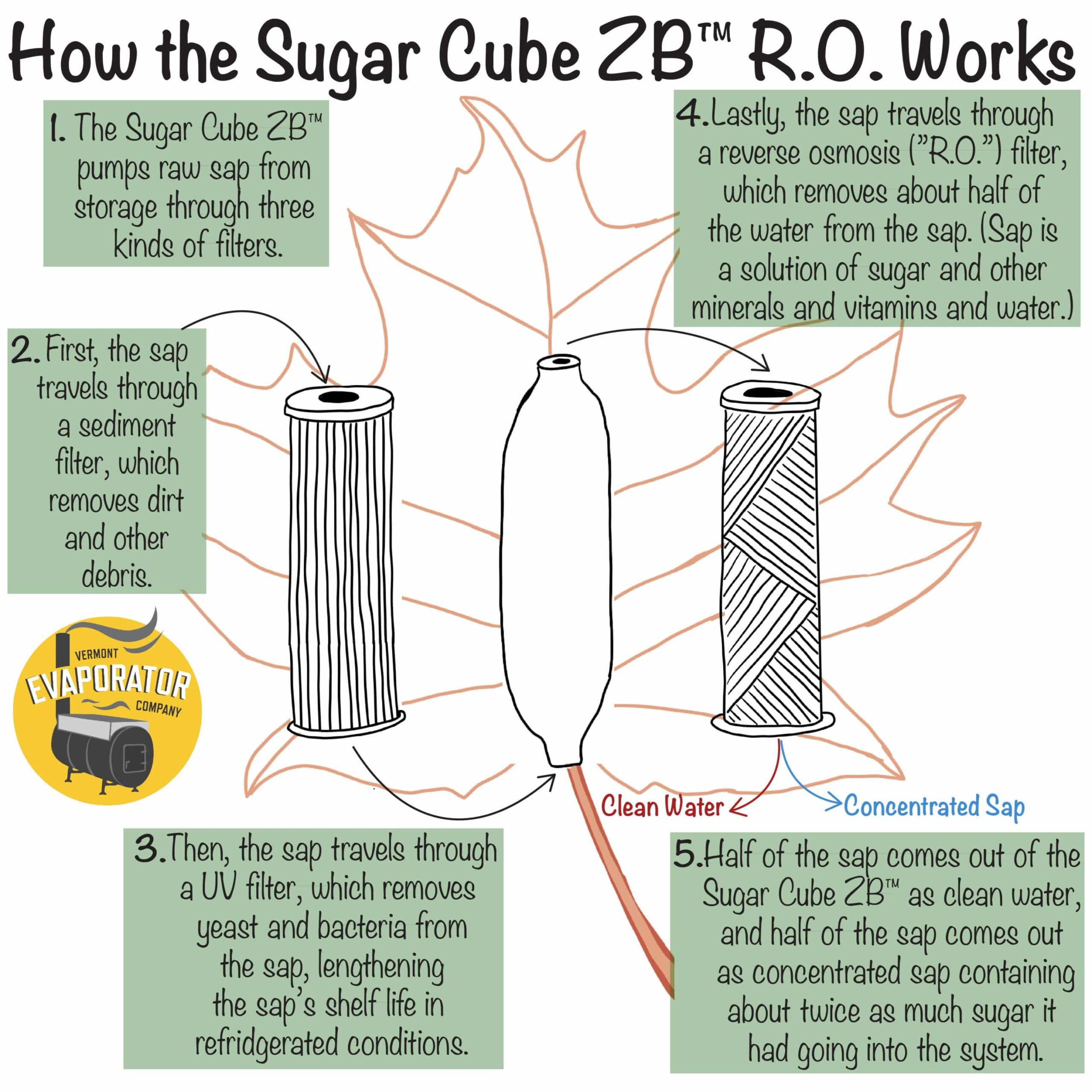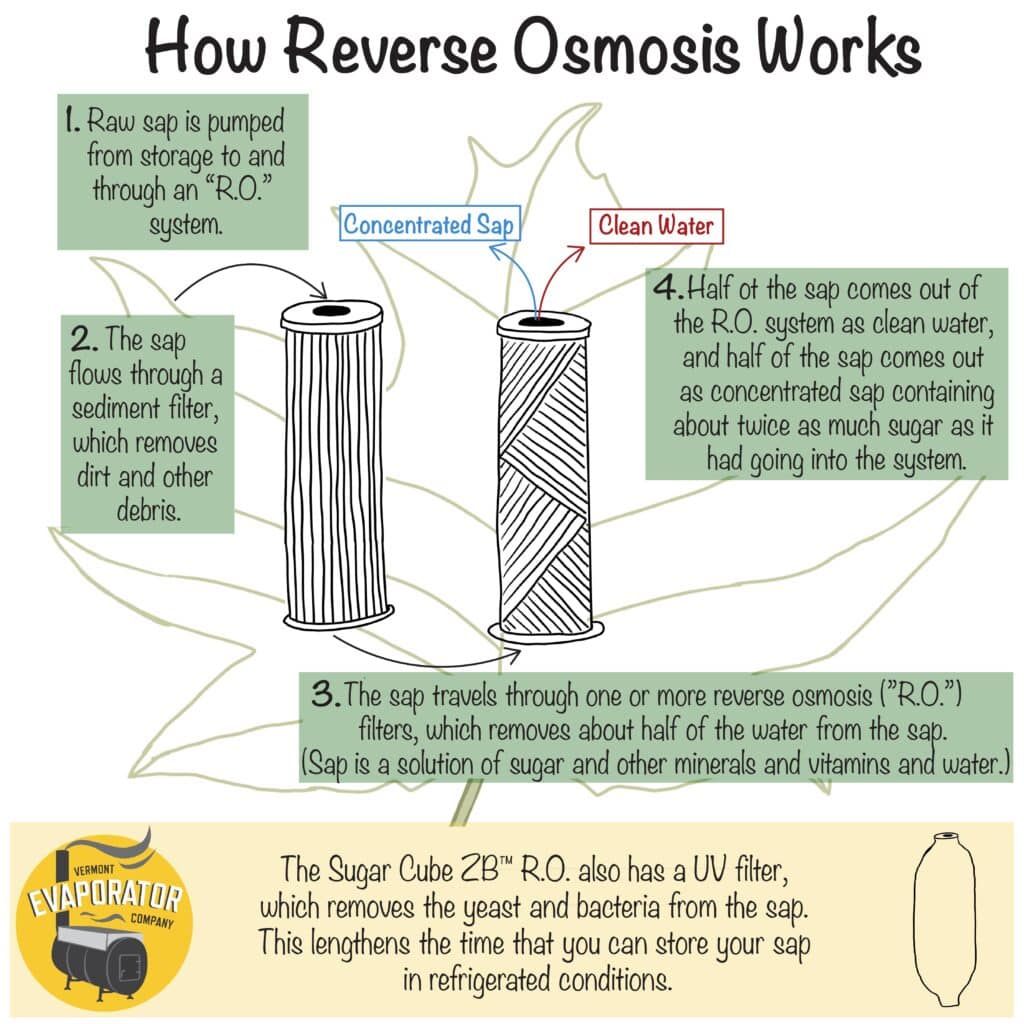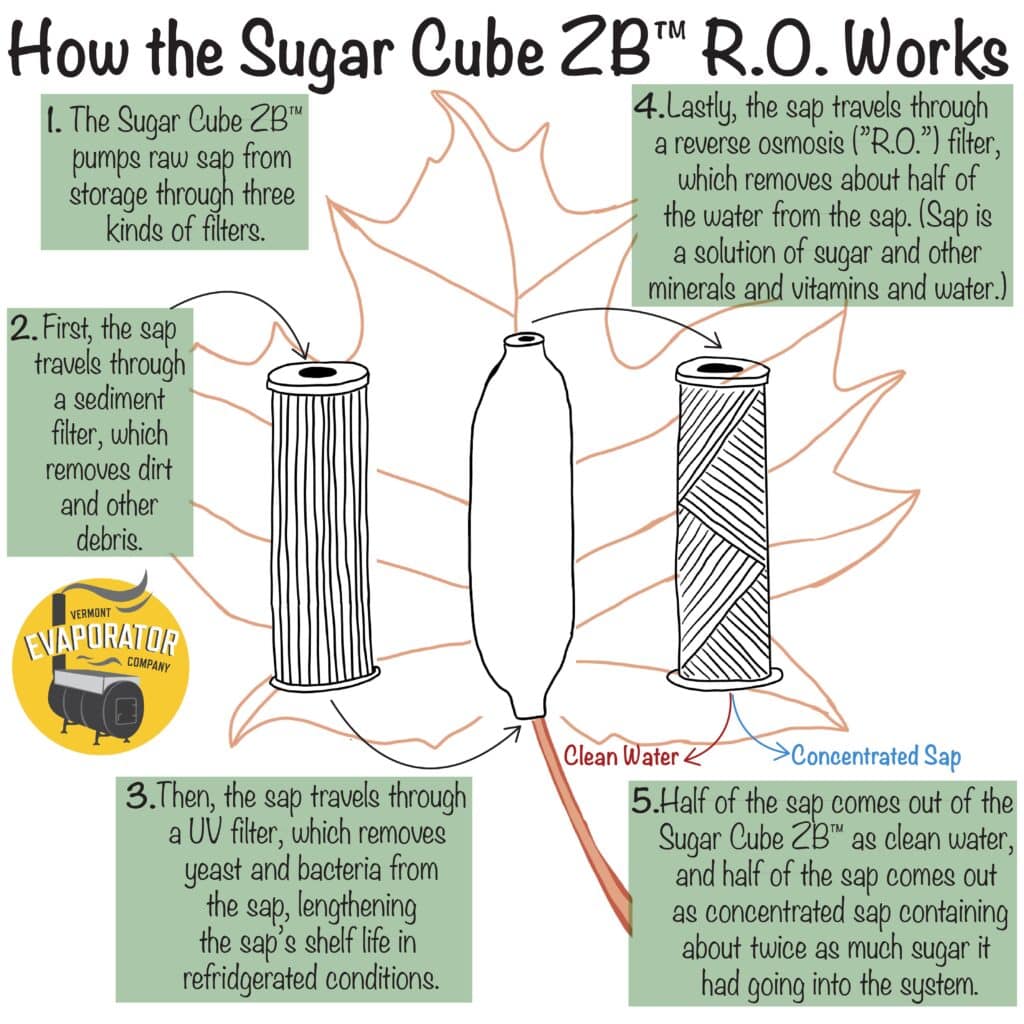Reverse osmosis has become ubiquitous in the maple syrup industry. But how does reverse osmosis work?
What is Reverse Osmosis?
Reverse osmosis is a system that separates water molecules from other substances found in liquids. Reverse osmosis systems can be found in many different applications involving water purification. Reverse osmosis is also used in the food industry to consolidate liquids like fruit juices and milk, and, of course, to concentrate maple sap.
In the water purification context, liquid is put through reverse osmosis to remove toxins and unwanted particulates from water so that it can be safe for use. In the context of adding value to foods, reverse osmosis removes water from liquids that contain things like sugars, vitamins and minerals so that the dehydrated results can be sold as food commodities like frozen fruit juice concentrate, evaporated milk, whey protein powder and maple syrup, cream candy and sugar!
Anyone who has ever made maple syrup knows that it takes a lot of time and energy to do so. For professional maple syrup makers, time and energy are synonymous with money. That’s why, in the middle of the 20th Century, maple syrup makers started using reverse osmosis to speed things up and cut energy costs by removing some of the water from sap before boiling.
Basic reverse osmosis units for maple syrup making remove half of the water from maple sap. Maple sap is about 2% sugar (also called 2 brix) when it comes out of the tree, and needs to be 67% – 69% sugar (or 67-69 brix) to be considered marketable maple syrup. When half of the water is taken away from sap with 2% sugar, it becomes concentrated sap with 4% sugar in it. A second pass through a basic reverse osmosis system can make that 4% sugar solution an 8% sugar solution! While that is still far away from the 68% or so percent it needs to be to be considered syrup, one pass through reverse osmosis cuts your time and energy needs in half. Two passes through reverse osmosis allows you to make the same amount of maple syrup in a quarter of the amount of time and with a quarter of the energy. Not bad!
How Does Reverse Osmosis Work?
Reverse osmosis works by forcing sap – a solution of water, sugar, vitamins and minerals – through a series of filters. This is done with the aid of a pump. First, the sap is pumped through a sediment filter, which removes things like bugs, and bits of leaf, bark and twig that may have gotten into the sap on its way from tree to storage. These sediment filters are long, cylindrical filters with tight, vertical folds, as shown below.
Next, the sap is forced through one or more reverse osmosis filters. These filters are of a more dense construction than the sediment filter: they appear, as shown below, almost like a very small cord has been wrapped around a cylinder multiple times creating a parkay-like overlap. The reverse osmosis filters are more dense because they are designed to separate things at the molecular level. That is to say, a reverse osmosis filter is so fine that it “catches” the sugar, vitamin and mineral molucules in sap, allowing pure water to be separated from it.
Some reverse osmosis systems, like the Sugar Cube ZB, have only one reverse osmosis filter. Others have two or more. How much water can be separated from sap and at what rate (and thus how concentrated the resulting sap concentrate is and how fast a reverse osmosis can filter) is a function of pump strength as well as the size of the “holes” in the reverse osmosis filter (measured in microns) and the number of reverse osmosis filters used.
Basic reverse osmosis systems for maple syrup remove half of the water from maple sap each time the sap is pumped through the system. (See above.) That means that half of the sap comes out of the reverse osmosis system as clean water and half comes out as concentrated sap containing twice the amount of sugar as it had going into the system in the first place.
How Does the Sugar Cube ZB, RO work?
The Sugar Cube ZB works in much the same way other hobby sized reverse osmosis units work, but with a small twist: the Sugar Cube ZB pumps sap through three different kinds of filters instead of just two. Just as in other reverse osmosis systems, sap is forced through a sediment filter first to remove larger debris. Next, however, the sap flows through an ultra violet (UV) filter, which removes yeast an bacteria from the sap. Lastly, the sap travels through a reverse osmosis filter, which, just like other ROs, removes about half or the water from sap.
The addition of the UV filter allows people to store sap for longer in clean, refrigerated conditions. By killing yeast and bacteria, the Sugar Cube ZB essentially extends the shelf life of refrigerated sap beyond the conventional wisdom of “a week or so.” How long can sap be stored when it’s been put through UV? We agree with The University of Vermont’s Proctor Maple Research Center that “it depends.” Our best answer? “Longer!”
you
Should I use Reverse Osmosis in my DIY Maple Syrup Operation?
The advantages of reverse osmosis to the professional maple syrup maker are obvoius. The cost of acquiring, running and maintaining reverse osmosis units is more than offsett by savings in labor and energy. Otherwise, the systems would not be as widespread in the industry as they are today. But is reverse osmosis something hobbyists do?
The simple answer is yes!
While some hobbyists do not want to complicate their maple syrup tradition by purchasing a plug-in appliance, and others worry that the resulting syrup won’t be as tasty (we disagree), many DIY maple syrup makers also employ reverse osmosis systems in their backyards.
We think reverse osmosis is an exciting addition to a maple syrup hobby because it has the potential to remove one of the biggest obstacles to making maple syrup in the first place – time! One pass through a typical hobby sized reverse osmosis system cuts boiling time in half!
Reverse osmosis can also help you make the most of your existing evaporating setup by allowing you to double the number of taps you have without making an equipment upgrade.
One final benefit that our reverse osmosis system – the Sugar Cube Z.B.– offers, of course, is that it kills yeast and bacteria in sap so that it can be stored longer between boils. If you are the kind of hobbiest that can’t boil every single weekend, or wants to take a vacation in March, you might consider the Sugar Cube Z.B. as a way to have your cake and eat it too!
FOR MORE INFORMATION ON MAKING YOUR OWN, HOMEMADE MAPLE SYRUP CHECK OUT OUR OTHER HELPFUL HOW-TO BLOGS:
How to Filter Homemade Maple Syrup



